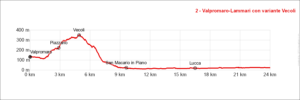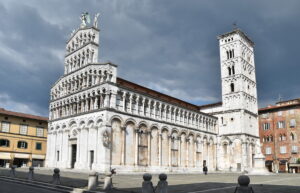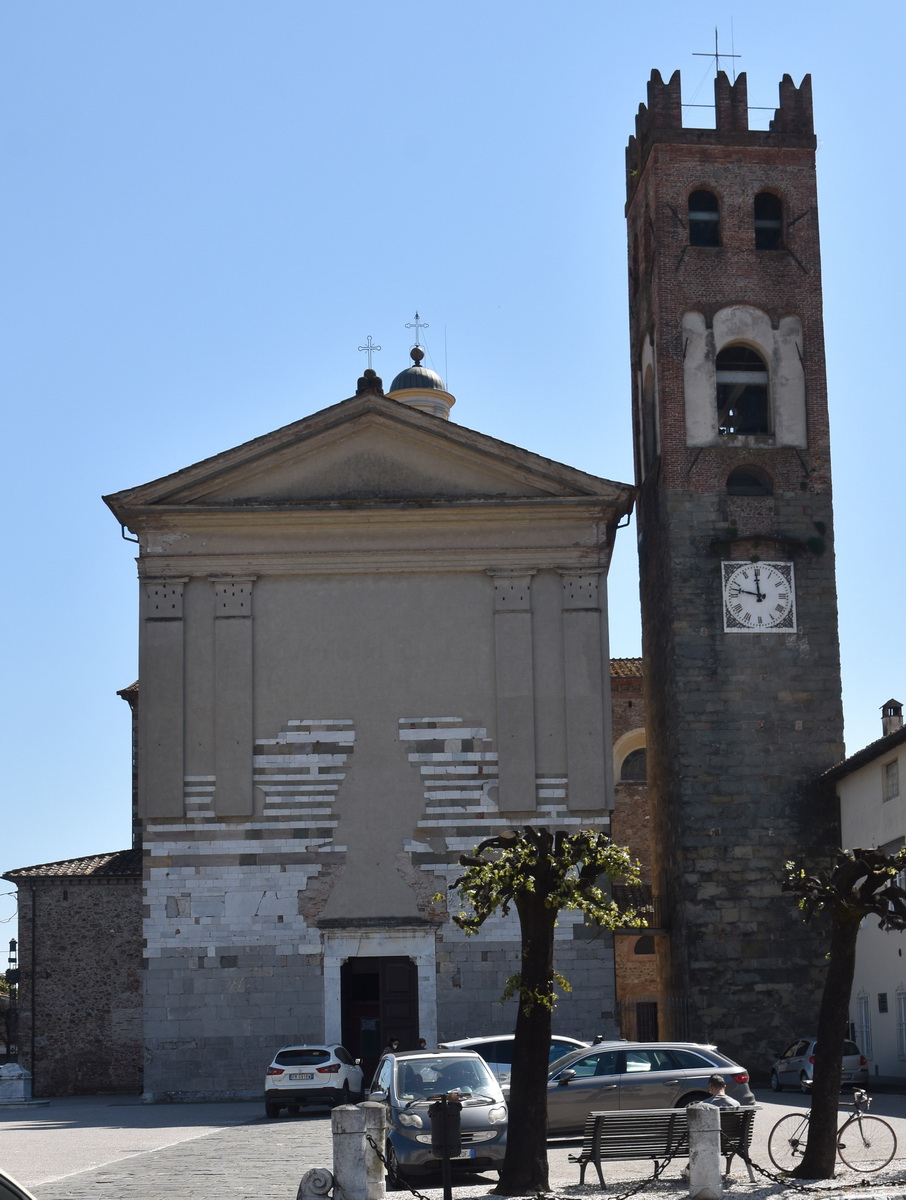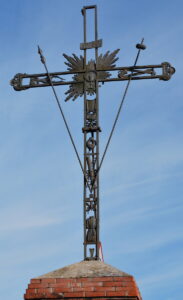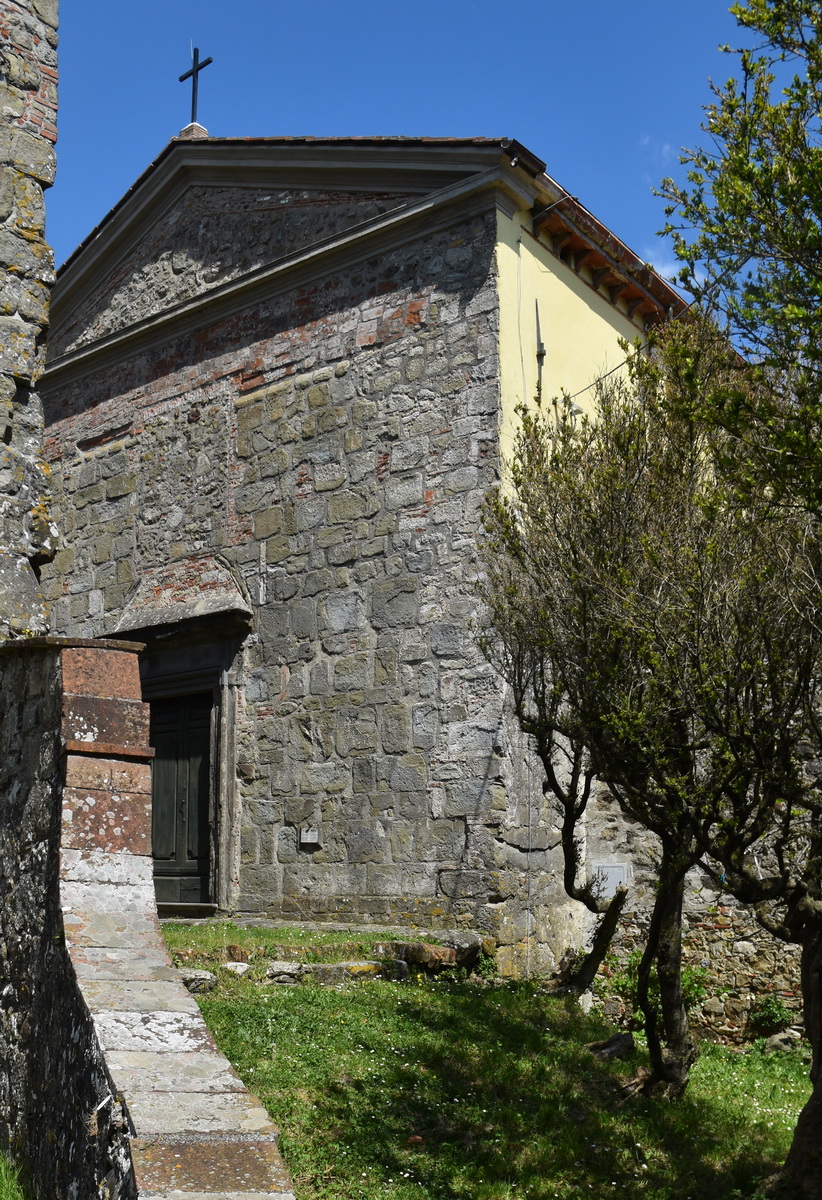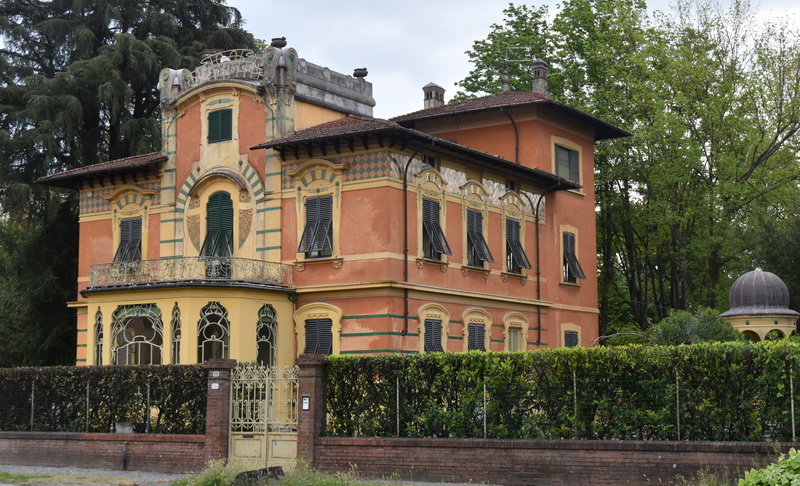Stage 2 – Valpromaro / Lammari
FIRST HALF STAGE – From Valpromaro to Lucca – km 16,3
We leave Valpromaro and soon leave Valfreddana going up to Piazzano: here we have a choose between two routes that meet in San Macario al Piano. Our approach to Lucca will be along the banks of the Serchio.
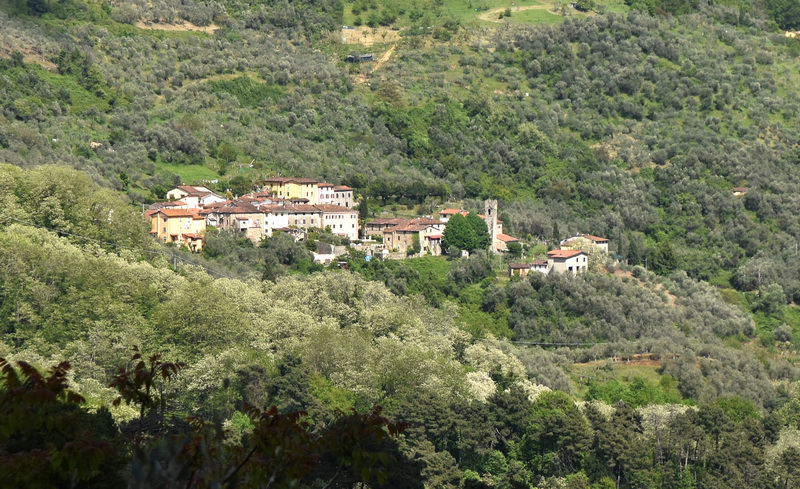
We leave the hostel of Valpromaro (km 0) continuing on the right until we exit the village: before reaching the SP1 we take a small road on the right that runs rpughly at the foot of the hill between the woods and cultivated fields until we reach an asphalted road, in proximity of the SP1. We turn sharply to the right and, at the end of a straight section, we turn right onto a dirt track through the woods that runs along the banks of a stream and climbs up to reach the asphalted road, turning left we proceed to the beautiful village of Piazzano (km 2.8).
Here we have two possibilities: follow the official route of the Via Francigena going down to the paved road Fibbialla / San Macario (Via delle Gavine) and following it up to the latter village or follow the profile of the hills finally descending to San Macario. The first route is shorter but less pleasant and takes place entirely on asphalt; the second is panoramic, much nicer and takes place almost exclusively on dirt roads: the length is almost the same but it has a greater 95 metres more difference in height..
Official route. We cross the village and follow the asphalted road that goes down a little to reach the cemetery. Here the old route used a path in the woods that descended rapidly up to via delle Gavine. However, given financial constraints, the Municipality of Lucca intends to close it for transit. We must therefore continue along the asphalted road, with very modest traffic, which will lead us to reach the valley floor by taking via delle Gavine, the Fibbialla / San Macario al Piano road. We follow it paying attention: there is usually not a lot of traffic, but there are no sidewalks or pedestrian platforms. We arrive at a crossroads: here our path joins with the alternative one. (km 8,4)
Alternative route. At the beginning of the village we go up to a steep slope to the left along a rough concrete road that soon becomes a wide dirt road. We walk mostly in wood, with occasional wide views of, below us Piazzano, further away Fibbialla, and in the distance, the Versilia hills. After the first stretch the slope eases proceeding with short ups and downs: we meet a dirt road (asphalted for the first few metres) and take the left branch. Finally we arrive at an asphalted road: we follow it to the right and head towards Vecoli. We proceed on the level along the saddle of the hill reaching the height of a beautiful ancient villa, the “Maria Bianca house of the Lateran Fathers”. At the end there is a small chapel: we must leave the asphalt and take the dirt road, to the right of the chapel, that climbs up to quickly reach the splendid Pieve di Vecoli church with bell tower and a small cemetery. Continuing we pass the back of the church where a CEIS community is located: here we can find water to drink. Beyond the enclosed garden of the community we see a square: we must bend to the right and open, if we find it closed, a wooden gate [no worries, the passage is authorized]. Keeping the road on the left, we go downhill along a grassy track.
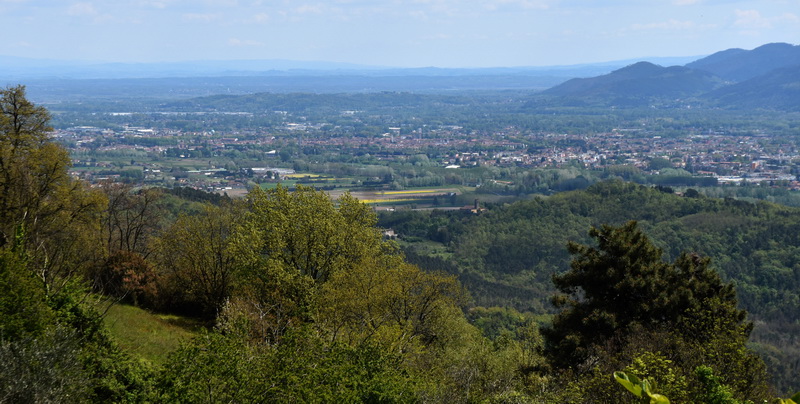
From here on, the panorama in front of us is truly grandiose, and ranges from the mountains above Livorno, the Pisan mountains, to the plains between Pisa and Livorno, Lucca, and the Versilia hills.
We enter the wood after making two hairpin bends and then we bend sharply to the left coming out at the edge of a wood: below us pastures and, further down, a farmhouse with a recently planted vineyard. Here, the view is even more spectacular, if that is possible. We continue to skirt the woods until we find a path that goes down to the right onto the dirt road used as access for the farm. We quickly descend along dirt roads in the woods: be careful to distinguish the signs at the various intersections that we find. Further down, the road becomes asphalted until it reaches via delle Gavine rejoining the path of the Via Francigena.
In a short time we arrive at the village of San Macario in Piano. We leave the main road and, at the center of a bend, turn left (pay attention to the red and white signs !!) and follow the road that leads us to the embankment of a stream. We follow the road (but we can also walk on a track at the top of the embankment) until we reach the river Serchio and the historic bridge that crosses it: at the beginning we find a large cross of crucifixion (km 10,6).
We cross the bridge: turn left on the far side and walk along a pleasant and quiet riverside cycle / pedestrian path that will take us close to Lucca. We find benches, rest areas, fountains, shady places. When we reach the white metal bridge (km 13,9) we leave the track turning right. We pass next to shooting range and at the end of a straight line of almost 500 meters we turn left. From here up to the entrance to Lucca, we must pay attention to the red and white signs that guide us to cross the Sant’Anna district following a series of often busy urban streets, sometimes (but not always) with footpaths. Our goal is the San Donato gate to the ancient fortified city. We pass through the gate and find ourselves in a large square: we turn right until we find Via San Paolino which corresponds to the ancient Roman decumanus maximus, the main street that still crosses the city today. We follow it until we arrive in piazza San Michele with its marvelous church. (km. 16,3).
SECOND HALF STAGE – From Lucca to Lammari – km 8,2
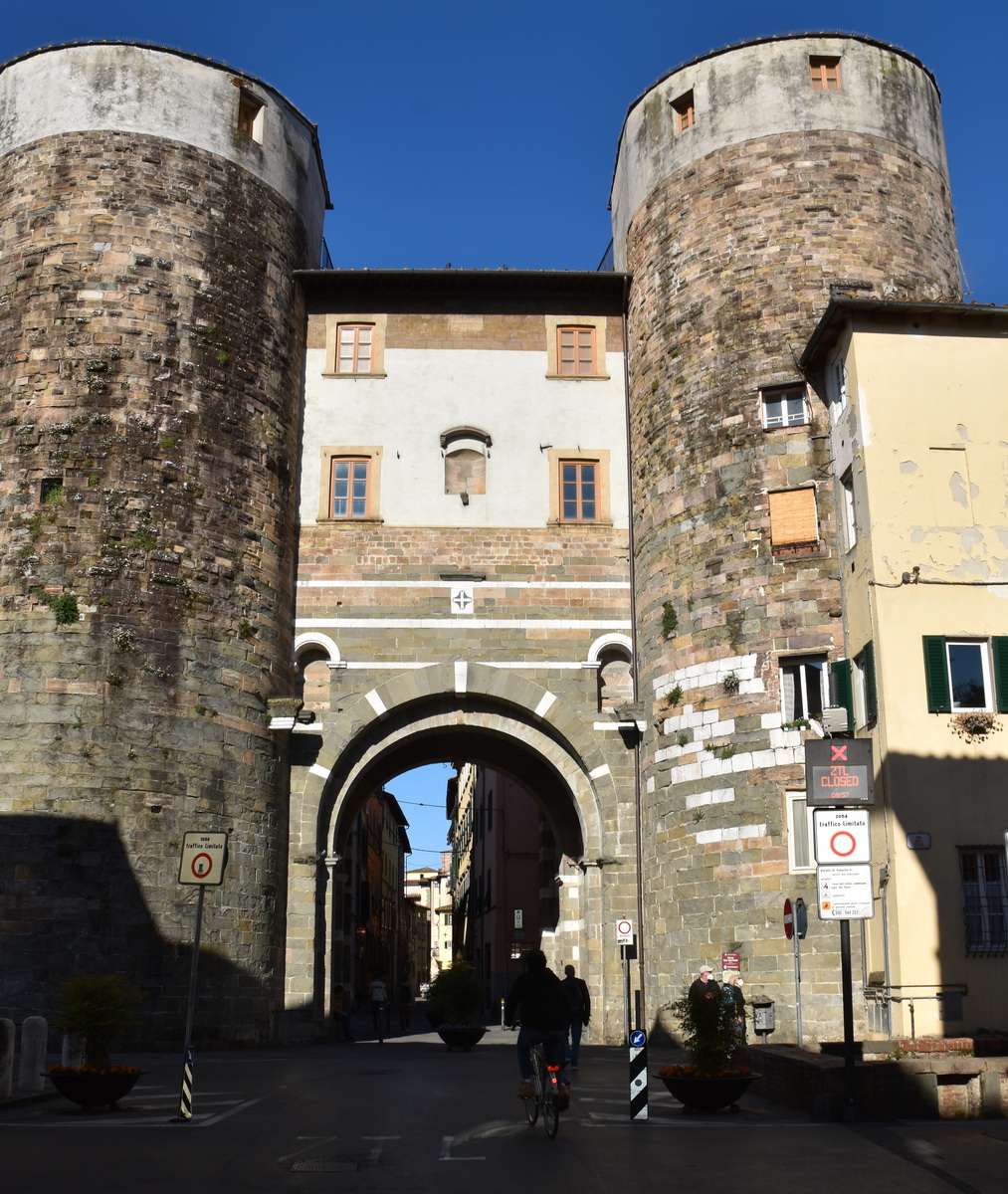
From Piazza San Michele we continue in the same direction on Via Roma, then Via Santa Croce which leads us through the ancient Porta San Gervasio. Here we find the ancient canal that for centuries has brought the water of the Serchio, it is known as “il Fosso”. We walk on the left along the suggestive Via del Fosso for all its length until we exit the historic center through Porta San Jacopo. Beyond the lawn surrounding the walls we follow Viale Agostino Marti to the left. Before arriving at a large roundabout we cross it and take Via Matteo Civitali on the right which we follow in the first straight section (500 meters). We observe a series of beautiful Art Nouveau villas. We reach and cross via del Brennero: at the end we have to make a double curve, first to the left and then to the right: it is a very busy road junction: so pay attention. After this point we are already outside the town, along a ring road: we walk along the first straight. At the end we come to a bridge over the Serchio: instead of crossing the bridge, we go down to the right and take a quiet road (Via della Macchia) that runs along the banks of the Serchio (km 18,9).
We finally walk in peace and silence. We stroll past several sports facilities. The road becomes a dirt road: shortly after we leave it and take a dirt road on the right that takes us to the SS12 del Brennero which we cross and turn left for Via Reggio (be careful because there is a lot of traffic!) Continuing on the quiet Via Pasquinetti which leads us to a parking area. Without entering it, we immediately turn left following a small road that runs alongside an industrial warehouse. After a small group of houses, we continue straight on a country road: beware that after 150 meters we turn right crossing a ditch and continue to cross a field.
At the end, we cross the tracks of the Lucca / Aulla railway line and continue until we soon arrive at via dell’Acquacalda, flanked by the il Fosso, that we have already encountered in Lucca. We follow it to the left for 600 meters paying attention to the traffic: the road has no footpath, but only a tiny walkway on the left side.
At the height of a bar (km 22,0) we cross it and take via del Borghetto. From this point up to Lammari we will travel along various narrow streets while maintaining the same WEST / EAST direction: the only exception is the double curve we have to make when we arrive in San Cassiano a Vico. We then cross the village along via delle Ville, via del Muletto and via di Mezzo. Then we walk along a beautiful country road that takes us to the beginning of the town of Lammari and its Pieve. (km 24,5)
services
LUCCA
Casa del Pellegrino San Nicolao (0.4 km from the Cathedral) – Via San Nicolao, 76 tel. 331.1311522 Hospitality in three single bedrooms and four in two larger rooms with respect for distances. Near Porta San Gervasio and a 10-minute walk from Piazza Anfiteatro. Donation hospitality owned by the Lateran Canons Regular and managed by volunteers (Donatella) – open all year. It has an area equipped with table, chairs, fridge, microwave oven and kettle. Reservation essential.
Pellegrinaio San Davino (1 km from the Duomo) Via San Leonardo, 12 tel. 0583.53576 – 366.1062641 sandavino@luccatranoi.it A total of 11 places with services and accommodation for the disabled.
LAMMARI
San Jacopo Apostolo Parish Hospitality – Via Lombarda tel. 0583.961845 with call forwarding. To be welcomed in the buildings adjacent to the church, contact Don Giovanni Romani at tel. 328.2935997. The hostel is always open and two rooms are ready with three beds each and shared bathroom. On the basis of requests, other rooms can be opened and other beds made. Large outdoor area. There is no washing machine but the use of the kitchen and the possibility of shared meals. Adjacent is the San Jacopo Tennis parish sports club (tel: 0583 962037) where you can eat something. It is essential to NOTICE at least the day before, the term BOOK is not used because it is not a hotel but a hospitality for pilgrims on a donation basis.
Don Giovanni often refuses the donation and in this case we recommend that you want to leave your contribution in the donation box in the church; he will know what to do with it.
Piazzano – San Macario in Piano – Ponte San Pietro
Bus line 555 CTT Lucca – Vaibus connects Ponte San Pietro to Piazzale Verdi in Lucca.
Lucca
Trenitalia – Lucca – Aulla line, Viareggio – Florence line, Pisa – Lucca – Pistoia line.
Bus line E15 CTT Lucca – Vaibus for Valpromaro – Camaiore.
Bus line 61 CTT Lucca – Vaibus for San Cassiano Vico and Lammari.
Taxi – parking on the square in front of the train station.
San Cassiano a Vico (near San Pietro a Vico)
Bus line 61 CTT Lucca – Vaibus for Lucca and Lammari.
Lammari
Bus line 61 CTT Lucca – Vaibus for Lucca.
Pharmacies: Lucca, San Pietro a Vico, Lammari
Hospitals: Lucca
Bar: Lucca, San Pietro a Vico, Lammari
Restaurants: Lucca, San Pietro a Vico, Lammari
Bank: Lucca, Lammari
Post Office: Lucca, Lammari
Railway Station: Lucca
Sports equipment: Lucca, Lammari
Food and Supermarket: Ponte San Pietro, Lucca, San Pietro a Vico, Lammari
Mechanical assistance service for bicycles: Lucca
For the first part of the route you can call the Valpromaro pilgrim reception. These are the contacts:
- Jacopo - 347.2723288
- Mirco - 347.8410569
- parish house / hostel: 0584.956028
For the Lucca / Capannori area you can call Eleonora: 328.9076318
places
Leaving Valpromaro and the Freddana valley, the villages of Piazzano and San Macario in Piano meet, finally reaching Ponte San Pietro where we cross the Serchio river. Ponte San Pietro takes its name from the bridge over the Serchio which was built in the tenth century to facilitate the journey of pilgrims and merchants from the coast. It was destroyed on several occasions, the last in World War II and is now decorated with the statue of St. Peter holding the cross of martyrdom and the keys of the kingdom of heaven, placed right in the center, the ideal protector of travelers. Shortly after, you will come across the town of Nave, located on the left bank of the Serchio, probably in memory of the ferry on the river established by Count Eriprando in the 9th century. Since then the place was called “ad navem Eriprandi”. This is the area of the Serchio River Park, with which the banks of the river have been recovered and re-evaluated, which is now a very popular green space, where you can walk, exercise and enjoy your free time.
Lucca is probably the city that hosts the greatest architectural and artistic heritage in relation to its surface. Worth a visit of several days. We therefore limit the indications to what is encountered on the path.
We enter the historic center from the capital through the Porta San Donato, the third of the Renaissance circle, located to the west of the city. Along the route of the ancient decumanus, you go from piazzale Verdi to the opposite side, crossing Piazza San Michele, formerly an ancient Roman forum. We arrive near the Cathedral of San Martino, the pilgrimage destination of the Holy Face, an ancient wooden Christ that legend has it carved by the hand of Nicodemus himself. The symbol of the city are the ancient walls that were built in the Renaissance period and have remained intact until today. They are made up of twelve embankment curtains, which join eleven bulwarks, with brick facing, twelve meters high and thirty meters wide at the base. They develop a length of over four kilometers entirely walkable, and are the best place to walk for residents and tourists who from there have a beautiful view of the bell towers, churches and towers that emerge from the roofs of the city.
The tourist information office is located in Piazza Verdi and offers visits to the many monuments and characteristic places. A very essential list includes the complex of the Cathedral of San Martino and Santa Reparata, San Michele in Foro, San Frediano and the convent complex of San Francesco; the national museums of Palazzo Mansi and Villa Guinigi; the square of the amphitheater and the tour of the walls. The same office carries out the service of stamping and issuing credentials to pilgrims.
For more informations: https://it.wikipedia.org/wiki/Lucca
San Pietro a Vico
It is a suburb of the city of Lucca. Rather decentralized from the village, the small railway station is one of the oldest on the Lucca-Aulla railway, dating back to the construction of the first section inaugurated on 11 February 1892. Between 1883 and 1932 it was served by the Lucca-Ponte a Moriano tramway. It was an important freight yard and a track connected the nearby Molino Pardini, now industrial archeology, to the network. A little further in the direction of Lammari, we meet
San Cassiano a Vico
A parish church built in the eighth century on a river island created by the Serchio in the area called Vicus Insularis. A section of the medieval wall, dating back to the 12th century, is integrated into the masonry of the current church. The church preserves majestic eighteenth-century altars inside; of particular importance is the largest, completed by a front with draperies made of stucco. At an altar on the right side there is a fresco from the second half of the fifteenth century depicting the venerated Madonna del Soccorso with Saints Sebastian and Nicola da Tolentino. Behind the main altar is a panel by Michelangelo di Pietro with the Madonna enthroned between Saints Cassiano and Biagio.
The Pieve di Lammari, called PLEBS SANCTAE MARIAE DE LAMMARI, originated in 904 and underwent profound transformations over the centuries: in the 12th century it was rebuilt, marble doors were installed and a series of arches were made; in the mid-15th century it was partially covered with limestone; in the eighteenth century it was raised and equipped with a dome and transept. The facade and the left side are the only parts that retain traces of the original facing, with remains of the decorative apparatus. The façade has a fifteenth-century portal by Marco da Como (1456), above which there are three bas-reliefs that originally were part of the tomb of the parish priest Lieto, sculpted by Biduino in the second half of the twelfth century. The lower part of the bell tower is in stone ashlars, while the upper part is in brick. Inside the temple it is possible to see the tabernacle with Christ in Pietà by Matteo Civitali (1496-1501), a terracotta San Leonardo from the second half of the 16th century, two marble angels placed in the chapel of the Santissimo, the baptismal font and the holy water tabernacle belonging to the Civitali school (1504). Among the paintings contained in the church stands out a table depicting the Madonna with child between Saints Nicholas, Bartolomeo and Antonio Abbot attributed to the artist Agostino Marti. There is also a Nativity by Gherardo delle Catene. In addition to the aforementioned works of art, the church preserves a precious organ by Domenico Cacioli, dating back to the second half of the seventeenth century.
along the way
The Crosses of the Passion are devotional crosses that carry the symbols of the Passion painted or shaped, including the pincers, the 3 nails, the hammer, the scourge, the dice, the crown, the column, the ladder, the title (INRI) , the glove, the host, the chalice, the reed with the sponge, the spear, a piece of rope, a rooster, and others. They are preferably located along the streets, at intersections, in front of churches.
VECOLI or VECOLE in the Serchio Valley – A solitary Romanesque church dedicated to the Santissima Annunziata with a small cemetery and a farmhouse, located in a position from which you can enjoy a splendid landscape. Located on the crest of the hill that separates the Freddana valley from that of the Contessora. In ancient times it was a parish and in 1832 it had 142 inhabitants. A magical place that invites you to stop for meditation.
Leaving Lucca we find ourselves along Via Civitali, a busy road that offers a roundup of beautiful Art Nouveau villas. They were built in the early 1900’s following a subdivision arranged to give order to the terraces outside the walls, and welcomed families of the rich bourgeoisie. A riot of art noveau, even in the factories and shops. At number 234, the famous Villa Ducloz, from 1903, surrounded by a large garden, a notable example of this style.
http://www.italialiberty.it/gaetanoorzali/
http://www.italialiberty.it/liberty-lucchese-con-villa-ducloz-barsanti/
http://it.wikipedia.org/wiki/Villa_Ducloz-Dianola

A stretch of the route that will not fail to hit is the narrow canal that accompanies us for a long stretch; this is the Via del Fosso, one of the most characteristic streets of Lucca, for defense purposes, the canal was built in 1376, following the layout of the walls still recognizable by the presence of two of the still existing medieval gates, that of Borgo and that of San Gervasio.
The water from the moat was used by the many artisan workshops located on its edge and in particular by those who worked silk. Lucca was a center of excellence for silk production, here new processing techniques were designed and implemented precisely by virtue of the use of hydraulic energy. A careful look allows you to observe that on the sides of the ditch there is a particular type of buildings, referable to the activities of silk: in particular the open terraces on the upper floors, used to spread the yarn, and the rooms covered by cross vaults on the ground floor to allow the use of particular mechanical devices moved by the water of the canal. The ditch was an integral part of the production scenery and it is easy to imagine the road animated by the workers with the skeins arranged on the walls of the ditches to dry.
The two neoclassical fountains located near the widening of the Madonna dello Stellario and Porta San Gervasio were designed in 1822 by the architect Lorenzo Nottolini.
Leaving southwards, near the access ramp to the Walls, there is the entrance to the nineteenth-century Botanical Garden and at the end of Via dei Fossi, the canal is buried under Corso Garibaldi. The area of Lucca that affects Piazza San Francesco, Via del Fosso, Via della Zecca, Porta dei Borghi, has recently had a lively cultural and commercial renaissance.

